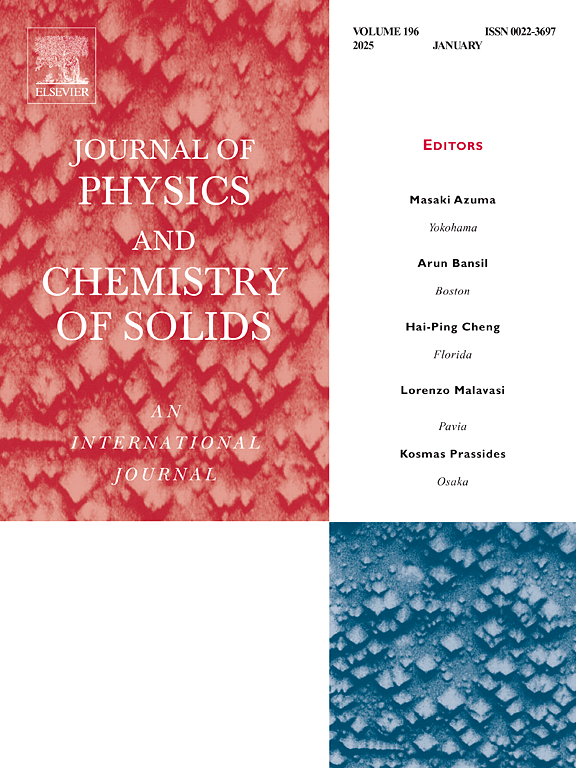Engineering of Cu and Ag-doped reduced graphene oxide for supercapacitor electrode applications
IF 4.3
3区 材料科学
Q2 CHEMISTRY, MULTIDISCIPLINARY
引用次数: 0
Abstract
This article explores the engineering of reduced graphene oxide (rGO) doped with copper (Cu) and silver (Ag) as cutting-edge electrode materials for high-performance supercapacitors. In the first step rGO was synthesized using improved hummers process with KMnO4 as oxidizing agent and H2SO4 and H3 PO4 as intercalating agent. Then, we utilized a facile and scalable co-precipitation method to develop Cu and Ag-doped rGO nanomaterials as electrode for supercapacitor applications. The successful doping and even dispersion of metal nanoparticles on the rGO sheets were validated via characterization utilizing Brunauer–Emmett-Teller (BET), X-ray diffraction (XRD), scanning electron microscopy (SEM), and Fourier transform infrared spectroscopy (FT-IR). In terms of cycling stability and specific capacitance, Cu, and Ag doped rGO composites outperformed then pristine rGO in electrochemical tests such galvanostatic charge-discharge (GCD) and cyclic voltammetry (CV). Hence, the optimized electrochemical investigation showed that, the 0.25 M Cu-rGO and 0.25 M Ag-rGO samples show small resistance and exhibited the higher specific capacitance of 584.2 F/g and 641.1 F/g respectively at scan rate of 5 mV/s. The energy density and power density of the Cu-rGO and Ag-rGO were calculated to be, 2.98 Wh/kg, 14.24 Wh/kg and 518.16 W/kg, 568.37 W/kg respectively. This study demonstrates a viable approach to creating sophisticated rGO-based electrode materials for energy storage devices of the future.
用于超级电容器电极的Cu和ag掺杂还原氧化石墨烯工程
本文探讨了掺杂铜(Cu)和银(Ag)的还原氧化石墨烯(rGO)作为高性能超级电容器的前沿电极材料的工程设计。第一步以KMnO4为氧化剂,H2SO4和h3po4为插层剂,采用改进hummers法合成氧化石墨烯。然后,我们利用一种简单且可扩展的共沉淀法开发了Cu和ag掺杂的氧化石墨烯纳米材料作为超级电容器应用的电极。通过布鲁诺尔-埃米特-泰勒(BET)、x射线衍射(XRD)、扫描电镜(SEM)和傅里叶变换红外光谱(FT-IR)等表征手段,验证了金属纳米颗粒在氧化石墨烯薄片上的成功掺杂和均匀分散。在恒流充放电(GCD)和循环伏安(CV)等电化学测试中,Cu和Ag掺杂rGO复合材料在循环稳定性和比电容方面优于原始rGO。因此,优化后的电化学研究表明,在扫描速率为5 mV/s时,0.25 M Cu-rGO和0.25 M Ag-rGO样品具有较小的电阻和较高的比电容,分别为584.2 F/g和641.1 F/g。计算得到Cu-rGO和Ag-rGO的能量密度分别为2.98 Wh/kg、14.24 Wh/kg和518.16 W/kg、568.37 W/kg。这项研究展示了一种可行的方法,可以为未来的储能设备创造复杂的rgo基电极材料。
本文章由计算机程序翻译,如有差异,请以英文原文为准。
求助全文
约1分钟内获得全文
求助全文
来源期刊
CiteScore
7.80
自引率
2.50%
发文量
605
审稿时长
40 days
期刊介绍:
The Journal of Physics and Chemistry of Solids is a well-established international medium for publication of archival research in condensed matter and materials sciences. Areas of interest broadly include experimental and theoretical research on electronic, magnetic, spectroscopic and structural properties as well as the statistical mechanics and thermodynamics of materials. The focus is on gaining physical and chemical insight into the properties and potential applications of condensed matter systems.
Within the broad scope of the journal, beyond regular contributions, the editors have identified submissions in the following areas of physics and chemistry of solids to be of special current interest to the journal:
Low-dimensional systems
Exotic states of quantum electron matter including topological phases
Energy conversion and storage
Interfaces, nanoparticles and catalysts.

 求助内容:
求助内容: 应助结果提醒方式:
应助结果提醒方式:


